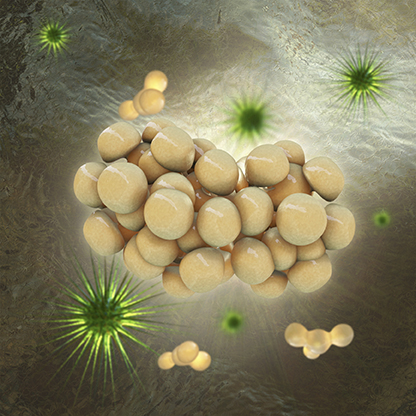Human adipose-derived stem cells (hASCs) appear to provide a viable alternative to bone-marrow derived stem cells in regenerative medicine. Bone marrow has been used for many years as a treatment of leukemia, and the mesenchymal stem cells (MSCs) contained in transplanted bone marrow have been shown to differentiate into tissue-specific cells in various organs. Although previous results suggested that MSCs derived from bone marrow or skin contain a fraction of pluripotent or multipotent cells, the multipotent cells were not well characterized, because they were considered very rare and lacked a specific surface marker. Kuroda et al. reported a unique subset of human MSCs that can be efficiently isolated as cells double positive for mesenchymal marker CD105+ and human pluripotent stem cell marker stage specific embryonic antigen (SSEA)-3+ cells. They are also able to self-renew and differentiate into cells representative of all three germ layers, namely endodermal, ectodermal, and mesodermal cells from a single cell. These cells were initially identified by applying stress to MSCs and were termed multilineage differentiating stress-enduring cells (Muse cells). Although Muse cells do not have high proliferative activity, they were reported to generate multiple cell types of the three germ layers without inducing unfavorable tumors.
Thus, Muse cells appear to be safer than other induced pluripotent or multipotent cells and might have better therapeutic potential than general (non-Muse) MSCs. Although Muse cells were not identified in animals other than a goat, they have been sparsely detected around vessels in various human mesodermal organs or tissues such as the skin and subcutis. Muse cells were also reported to home to injured regions and spontaneously differentiate into tissue specific functional cells in the damaged liver, skin, and skeletal muscle in animal models. In the present report, SSEA-3+ Muse cells were isolated from patient-derived human adipose tissue-derived stem/stromal cells (hASCs). Adipose-derived Muse cells were characterized and evaluated for therapeutic potential in treating diabetic refractory skin ulcers. Skin ulcers under ischemic conditions generally show delayed wound healing and are typical therapeutic targets of cell-based therapies using MSCs or endothelial progenitor cells.
In order to investigate whether Muse cells are superior to other MSCs, the study compared wound healing of skin defects in diabetic mice between treatments with the two distinct cell populations.
Stage-specific embryonic antigen-3 (SSEA-3)-positive multipotent mesenchymal cells (multilineage differentiating stress-enduring [Muse] cells) were isolated from cultured human adipose tissue derived stem/stromal cells (hASCs) and characterized, and their therapeutic potential for treating diabetic skin ulcers was evaluated. Cultured hASCs were separated using magnetic-activated cell sorting into positive and negative fractions, a SSEA-3+ cell-enriched fraction (Muse-rich) and the remaining fraction (Muse-poor). Muse-rich hASCs showed upregulated and downregulated pluripotency and cell proliferation genes, respectively, compared with Muse-poor hASCs. These cells also released higher amounts of certain growth factors, particularly under hypoxic conditions, compared with Muse-poor cells.
Skin ulcers were generated in severe combined immunodeficiency (SCID) mice with type 1 diabetes, which showed delayed wound healing compared with nondiabetic SCID mice. Treatment with Muse-rich cells significantly accelerated wound healing compared with treatment with Muse-poor cells. Transplanted cells were integrated into the regenerated dermis as vascular endothelial cells and other cells. However, they were not detected in the surrounding intact regions. Thus, the selected population of ASCs has greater therapeutic effects to accelerate impaired wound healing associated with type 1 diabetes. These cells can be achieved in large amounts with minimal morbidity and could be a practical tool for a variety of stem cell-depleted or ischemic conditions of various organs and tissues.
In the present study, a selected population of ASCs, namely Muse cells, was shown to have greater therapeutic effects in accelerating the impaired wound healing associated with type 1 DM. On the basis of the suspected mechanisms, the data gathered further suggest their clinical potential in a variety of stem cell-depleted or ischemic conditions of any organ or tissue. Adipose tissue has been gaining more attention as a practical source of adult stem cells.
The therapeutic potentials of ASCs were suggested for treating various DM conditions, such as hyperglycemia and autoimmune DM. ASCs were shown to share most biological characteristics, and to have comparable functions, with bone marrow-derived MSCs. Recent studies have suggested that ASCs (and also other tissue-resident MSCs) can be supplied from the bone marrow as tissue-localized stem/progenitor cells.
Bone marrow is the central factory and bank of stem/ progenitor cells, which are mobilized and delivered on demand by peripheral organs. These data suggest that invasive damage to the bone marrow while harvesting bone marrow-derived cells might have been underestimated. ASCs can be obtained in much larger quantities using minimally invasive approaches that will not damage the bone marrow, suggesting a clinical potential for Muse ASCs in the future.







